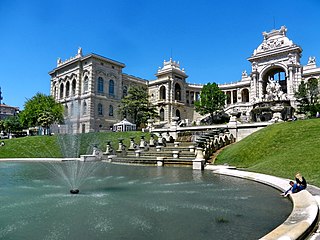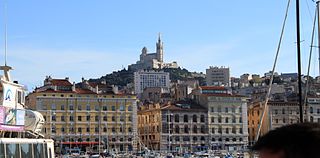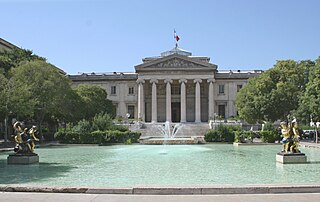
Aix-en-Provence, or simply Aix, is a city and commune in southern France, about 30 km (20 mi) north of Marseille. A former capital of Provence, it is the subprefecture of the arrondissement of Aix-en-Provence, in the department of Bouches-du-Rhône, in the region of Provence-Alpes-Côte d'Azur. The population of Aix-en-Provence is approximately 145,000. Its inhabitants are called Aixois or, less commonly, Aquisextains.

Tourism in France directly contributed 79.8 billion euros to gross domestic product (GDP) in 2013, 30% of which comes from international visitors and 70% from domestic tourism spending. The total contribution of travel and tourism represents 9.7% of GDP and supports 2.9 million jobs in the country. Tourism contributes significantly to the balance of payments.

Provence-Alpes-Côte d'Azur, also known as Région Sud, is one of the eighteen administrative regions of France, located at the far southeastern point of the mainland. The main prefecture and largest city is Marseille, France's second-largest urban area after Paris, with slightly less than one million residents.

The Trocadéro, site of the Palais de Chaillot, is an area of Paris, France, in the 16th arrondissement, across the Seine from the Eiffel Tower. It is also the name of the 1878 Trocadéro Palace which was demolished in 1937 to make way for the Palais de Chaillot. The hill of the Trocadéro is the hill of Chaillot, a former village.

The arrondissement of Marseille is an arrondissement of France in the Bouches-du-Rhône department in the Provence-Alpes-Côte d'Azur region. It has 21 communes. Its population is 1,069,909 (2016), and its area is 683.2 km2 (263.8 sq mi).

The University of the Mediterranean Aix-Marseille II was a French university in the Academy of Aix and Marseille. Historically, it was part of the University of Aix-Marseille based across the communes of Aix-en-Provence and Marseille in southern France. It had 24,000 students.

The Muséum d’histoire naturel de Marseille, also known in English as the Natural History Museum of Marseille, is one of the most visited natural history museums in France. It was founded in 1819 by Jean-Baptiste, marquis de Montgrand and Christophe de Villeneuve-Bargemon, prefect of the Bouches-du-Rhône department. It is located in the Palais Longchamp, 4th arrondissement of Marseille, built according to the plans of Henri-Jacques Espérandieu.
The architecture of Provence includes a rich collection of monuments from the Roman era, Cistercian monasteries from the Romanesque period, medieval castles and fortifications, as well as numerous hilltop villages and fine churches. Provence was a very poor region after the 18th century, but in the 20th century it had an economic revival and became the site of one of the most influential buildings of the 20th century, the Unité d'Habitation of the architect Le Corbusier in Marseille.

The Canal de Marseille is a major source of drinking water for all of Marseille, the largest city in Provence, France. The canal, along its main artery, is 80 kilometres (50 mi) long and has additional 160 kilometres (99 mi) of minor arteries. Its construction lasted 15 years and was directed by the engineer Franz Mayor de Montricher. The canal became functional on July 8, 1849.
Claude Le Baube (1919–2007) was a painter and sea captain.

The Palais Longchamp is a monument in the 4th arrondissement of Marseille, France. It houses both the Musée des beaux-arts and the Muséum d'histoire naturelle de Marseille. The surrounding Longchamp Park is listed by the French Ministry of Culture as one of the Notable Gardens of France.

Baron Charles Frédéric Chassériau du Chiron was a Saint Dominican architect and painter, who served as chief architect of the cities of Marseille, Algiers, in Algeria; and Cairo, in Egypt. He is particularly known for having designed the seafront of the city of Algiers.
The following is a timeline of the history of the city of Marseille, France.

Marseille or Marseilles is the prefecture of the French department of Bouches-du-Rhône and of the Provence-Alpes-Côte d'Azur region. Situated in the Provence region of southern France, it is located on the coast of the Gulf of Lion, part of the Mediterranean Sea, near the mouth of the Rhône river. A resident of Marseille is a Marseillais.

The Aix-Marseille-Provence Metropolis is the métropole, an intercommunal structure, centred on the cities of Marseille and Aix-en-Provence. It is located in the Bouches-du-Rhône, Var and Vaucluse departments, in the Provence-Alpes-Côte d'Azur region, southeastern France. It was created in January 2016, replacing the previous Communauté urbaine Marseille Provence Métropole and five communautés d'agglomération. Its area is 3149.2 km2. Its population was 1,889,666 in 2018, of which 868,277 in Marseille proper and 143,097 in Aix-en-Provence.

The Marseille Courthouse is a neoclassical building located on Place Montyon, in the 6th arrondissement of Marseille, France.
The Palais omnisports Marseille Grand-Est, abbreviated as POMGE, is a multi-purpose arena primarily used as an ice rink, located in Marseille, Bouches-du-Rhône, France. It is the home venue for ice hockey team Spartiates de Marseille. The complex also houses a skate park which, at the time of its opening, was billed as the largest such indoor installation in Europe.
It was inaugurated in 2009, and is popularly known as Patinoire de la Capelette after the Marseille quarter it sits in, la Capelette.
Thiers is a neighbourhood of the 1st arrondissement of Marseille. A cultural and student quarter in the centre of Marseille, it is located between Place Jean-Jaurès and La Canebière, near the Vieux-Port.

The École du Pharo is a French military school specialized in teaching and researching tropical medicine, based in Marseille on the grounds of the Palais du Pharo.
















